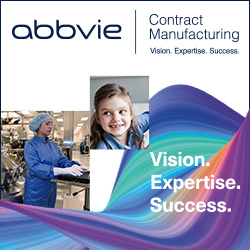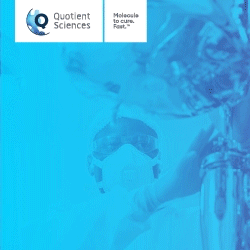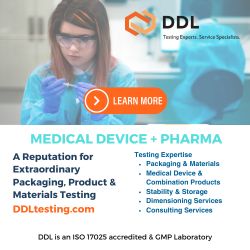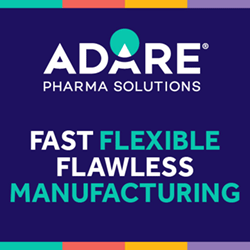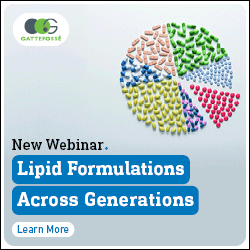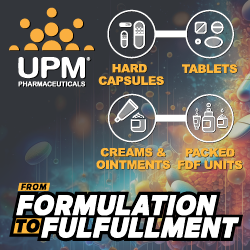Issue:January/February 2025
FORMULATION FORUM - Nanoparticle Technologies for Oral Delivery of Peptides & Proteins
INTRODUCTION
As we continue to embark on development of poorly soluble molecules for oral delivery, more specifically the large molecules like peptides and proteins, the solubility, permeability, and bioavailability challenges are surmounting. This is due, in part, to a lack of excipients and technologies to overcome these barriers stemming from appropriate stability and desired efficacy of drug molecules.1 As the global market of peptide and protein drugs (PPDs) continues to gain market share to over $51 billion by 2027 with CAGR of about 9%, many of the drugs for treatment of metabolic diseases, such as the glucagon-like peptide (GLP-1) analogs liraglutide (Victoza®) and semaglutide (Rybelsus®), among others, will continue to fuel the growth in the future.2 Ion pairing of polypeptides with negatively charges surfactants encapsulated in self-emulsifying drug delivery systems (SEDDS) will likely pave the way in oral delivery of innovative peptides.3,4 Oral drug delivery technologies will therefore play a key role in transporting the drug through the epithelial membrane in the GI tract. Coupled with urgent medical needs, it will lead drug manufacturers to look for innovative oral delivery technologies for targeting cancers, diabetes, bacterial and viral infections, and other therapeutic areas.
Oral bioavailability of PPDs falls below 2% mainly because of two reasons: 1) rapid degradation in the stomach and instability in the upper GI due to proteolytic enzymes and different pH conditions, and 2) poor permeability across GI membranes. On the other hand, colonic delivery benefits from lower enzymatic activities and around neutral pH, which could lead to improved absorption of PPDs through permeation enhancers. Nanoparticles could help protect these molecules from degradation and improve the permeation of PPDs.5 Let’s examine the nanoparticle technologies in oral delivery of large molecules.
NANOPARTICLE TECHNOLOGIES
Nanoparticles (NPs) ranging 1-100 nm in size are classified as liposomes; SLN, NLC, cubosomes, nanoemulsions, and microemulsions are widely recognized and well characterized for their lipids and polymers, structures, compositions, and physical properties. All these assemblies are aimed at improving solubility of Class II and Class IV drugs, as well for biologics and large molecules like peptides and proteins. Interest in NPs lies because they enhance solubility and also promote distribution and absorption of drugs through the intestinal epithelium in the GI tract.6 There are, however, some challenges lie primarily with mucus barriers that inhibit the permeation of drug molecules. To overcome these challenges, hydrophilic polymers or lipid-based excipients can protect drugs from degradation as well as can lead to improved epithelial uptake. For example, polyethylene glycol (PEG), when used with insulin NPs, showed an improved epithelial uptake with controlled degradation of drug.7 Lipid and surfactant-based NPs also demonstrate the enhanced uptake of drugs, and thus improve the bioavailability by several magnitudes while minimizing food effects.8 NP liposomes with <150 nm in size comprised of insulin in novel lipids improved the stability and targeted the hepatocytes, leading to significant uptake of drug through the hepatic portal vein following oral administration.9 In a clinical trial comparing the insulin vesicles and subcutaneous routes, it was observed that the oral bioavailability was markedly higher and it also significantly improved the tolerability and lacked any serious adverse effects.10 These findings led to advancement of further clinical trials for Type 1 diabetes.11 Figure 1 shows the possible routes for administration of oral peptides and proteins.

Another route for delivery of liquid formulations via the oral cavity for insulin is through RapidMist, which results in formation of micellar NPs stabilized with surfactants and permeation enhancers to maximize absorption and bioavailability. This device, so-called Oral-Lyn™, can deliver insulin to oral mucosa by micelles with a particle size of about 7 nm.12 This product has been approved by the FDA for treatment of patients with Type 1 and Type 2 diabetes.13
PERMEATION ENHANCERS
These agents are a class of compounds added with the intent to facilitate the penetration of drugs through the gastric and intestinal epithelium. These compounds help permeate peptides and proteins through mucosal membranes in the oral cavity as well. Formulated with a chelating agent, protease inhibitor, and lipid excipients with abilities to encapsulate and protect, they can help protect PPDs from the GI tract and influence their absorption. A protein oral delivery (POD) system composed of EDTA (a chelating agent), bile salt as permeation enhancer, and protease inhibitor can help protect insulin from hydrolysis in the stomach as well as improve the stability in the small intestine, while also minimizing degradation. Insulin formulated in POD is highly effective in lowering glucose levels in Type 1 and Type 2 diabetes patients.
Medium chain triglycerides and surfactants are used as enhancers for oral drug delivery, and work in part by enzymatic hydrolysis that leads to generation of fatty acids and that helps improve the absorption via mucous permeation in GI tract. For example, medium chain fatty acid like caprylic acid, which comprises of 2%-3% in milk fat, has been found to enhance absorption.14 Several other compounds, such as (N-5-chlorosalicyloyl)-8-aminocaprylic acid (5-CNAC), 4-(4-chloro-2-hydroxybenzoyl-amino) butanoic acid (4-CNAB), and N-(8-2-hydroxybenzoyl)-amino caprylic acid (SNAC) are also used as excellent permeation enhancers.15 Table 1 lists a number of permeation enhancer technologies applied in oral delivery of marketed polypeptides.16

Citing a few examples: SNAC was licensed by Novo Nordisk from Emisphere Technologies, and used first in oral delivery of vitamin B12 and later in semaglutide (Rybelsus®) oral tablets because of its ability to enhance bioavailability, safety, and lack of impact on tight junctions. It is argued that SNAC protects by complexing semaglutide in the stomach and releasing the drug in a concentration-dependent manner as it interacts with the stomach mucosal membrane.17 TPE™ technology used in formulation of Mycapssa® for oral delivery of octreotide showed significant bioavailability enhancement due to sodium caprylate, that acts as permeation enhancer, and its daily oral dose when compared with an injectable formulation was similar.18
Self-emulsifying drug delivery systems (SEDDS) composed of lipids, surfactants, and co-solvents, self-emulsify in GI fluids to smaller droplets or emulsions and microemulsions. There are several small molecules that have been approved in SEDDS/SMEDDS.19 In recent times, attention is also focused on delivery of oral peptides because of the ability for SEDDS/SMEDDS to enhance permeation through the mucus layer in intestine. Cyclosporine A is a marketed peptide approved as Sandimmune®/Neoral®. A SEDDS formulation composed of DMPG, Transcutol P, and a long chain triglyceride, led to high encapsulation and enhanced permeation of insulin via hydrophobic ion pair formation.20
ORAL POLYPEPTIDE APPROVED DRUGS
Table 2 lists the FDA-approved orally delivered polypeptides. These include a range of polypeptides, manufacturers, their indications, and enabling technologies.21

CLINICAL TRIALS
In spite of stability challenges with oral peptides and large molecules in gastric and intestinal pH conditions and due to proteolytic enzymes, innovation continues to find the optimized formulations to achieve greater stability and enhanced bioavailability. As previously described, polymeric excipients and solubilizers and permeation enhancers play an important role and as a result, only a few peptides and proteins are developed and launched. As the trend continues, there are several other candidates undergoing clinical studies. Table 3 shows some of the recent drugs undergoing clinical studies and the results still pending the outcome.

As shown in Table 3, Phase 1 human parathyroid hormone (1-34) is evaluated orally as RaniPill® (RT102) single dose in women volunteers in comparison with 20 mg subcutaneous dose of Forteo®.22 In another study, oral EB612 (EBP05) is investigated for hypoparathyroidism in a single daily dose of PTH (1-34) in comparison with SubQ dose of 100 mg of NATPARA PTH (1-84). In another study, Ovarest® (Leuprolide) 60-120 mg daily dose oral tablet is investigated in women with endometriosis in comparison with Lupron Depot for treatment of endometriosis.23
SUMMARY & FUTURE PERSPECTIVES
With few exceptions, many of the peptides and proteins are unstable in gastric and intestinal pH, and possess low permeability and absorption; therefore, these are commonly administered parenterally. Due to their inherent limited permeability and solubility, the industry continues to evaluate innovative technologies as well as to align with the desired pharmacological outcomes via oral delivery by modifying the structural changes. Permeation enhancers could play a crucial role to help facilitate the transport through gastric or intestinal epithelium membrane, leading to absorption via paracellular or transcellular routes. Nanoparticles composed of surfactants, medium chain fatty acids and triglycerides, and bile salts could temporarily affect the membrane integrity through their lipophilicities and hence could lead to increase in permeability. Taken together, it is obvious that a drug’s permeability and absorption through nanoparticles composed of lipids and/or surfactants via epithelial membrane will help improve the oral bioavailability of PPDs. As illustrated in Figure 1, the oral absorption of PPDs occurs through several routes. Thus, finding the right approach to an induvial polypeptide in NPs, stable for an extended period while transit in GI tract, remains the biggest challenge. Ascendia’s enabling platform technologies, AmorSol®, NanoSol®, EmulSol®, and LipidSol® could be explored for innovative large molecules in oral delivery of peptides and proteins. With its state-of-the-art cGMP manufacturing capabilities, Ascendia can lead the way for designing and manufacturing of drugs for oral delivery of PPDs.
REFERENCES
- S. Ali and K. Kolter, Challenges and Opportunities in Oral Formulation Development, Am. Pharm. Rev., December 2012.
- FDA. Novel Drug Approvals for 2020, www.fda.gov/drugs/new-drugs-fda-cders-newmolecular-entities-and-new-therapeutic-biological-products/ novel-drug-approvals-2020/.
- V. Claus, H. Spleis, C. Federer, K. Zoller, R. Wibel, F. Laffleur, C. Dumont, P. Caiss, A. Bernkop-Schnürch, Self-emulsifying drug delivery systems (SEDDS): In vivo-proof of concept for oral delivery of insulin glargine, Int. J. Pharm., 2023, 63, 122964. https://doi.org/10.1016/j.ijpharm.2023.12296.
- C. Menzel, T. Holzeisen, F. Laffleur, S. Zaichik, M. Abdulkarim, M. Gumbleton, and A.B. Schnurch, In vivo evaluation of an oral self-emulsifying delivery system (SEDDS) for exenatide, J. Contr. Rel., 2018, 277, 165-172.
- J. Zhong, B. Xia, S. Shan, A. Zheng, S. Zhang, J. Chen, and X. Liang, High-quality milk exosomes as oral drug delivery system. Biomaterials 2021, 277, 121126.
- C. Dumont, S. Bourgeois, H. Fessi, and V Jannin, Lipid-based nanosuspensions for oral delivery of peptides, a critical review. Int. J. Pharm., 2018, 541, 117–135.
- Y. Zheng, J. Wu, W. S. Lei, W. Rui, Z. Min L. Yi, C. Minglu, Z. Zhirong, and Z. Y. Huang, Multifunctional nanoparticles enable efficient oral delivery of biomacromolecules via improving payload stability and regulating the transcytosis pathway. ACS Appl. Mater. Interfaces, 2018, 10, 34039–34049.
- S. Noble and A. Markham, Cyclosporin: a review of the pharmacokinetic properties, clinical efficacy and tolerability of a microemulsion-based formulation (Neoral®). Drugs, 1995, 50, 924–94.
- E. Harris, An industry update: the latest news in therapeutic delivery. Ther. Deliv., 2017, 8, 939–946.
- W. B. Geho, H. C. Geho, J. R. Lau and T. J. Gana, Hepatic directed vesicle insulin: a review of formulation development and preclinical evaluation, J. Diab. Sci. Tech., 2009, 3, 1451-1459.
- Diasome. Rethinking Insulin, www.diasome.com/breakthrough-hdv-technology/.
- P. Pozzilli, P. Raskin, and C. G. Parkin, Review of clinical trials: update on oral insulin spray formulation. Diab. Obes. Metab., 2010, 12, 91–96.
- Clinical Trials Arena: Oral-Lyn- oral spray formulation of human insulin for Types 1 and 2 diabetes, www.clinicaltrialsarena.com/projects/oral-lyn/.
- S. Maher, R. J. Mrsny, and D. J. Brayden, Intestinal permeation enhancers for oral peptide delivery. Adv. Drug Deliv. Rev., 2016, 106, 277–319.
- C. Kapitza, E. Zijlstra, L. Heinemann, M. C. Castelli, G. Riley, and T. Heise, Oral insulin: A comparison with subcutaneous regular human insulin in patients with type 2 diabetes. Diab. Care, 2010, 33, 1288–1290.
- A. T. Zizzari, D. Pilatsika, F. M. Gall, T. Fischer and R. Reidl, New perspectives in oral peptide delivery, Drug Discovery Today, 2021, 26, 1097-1105.
- S. T. Buckley et al. (2018) Transcellular stomach absorption of a derivatized glucagon-like peptide-1 receptor agonist. Sci. Transl. Med., 2018, 10, eaar7047.
- Melmed, S. et al. (2015) Safety and efficacy of oral octreotide in acromegaly: results of a multicenter Phase III trial. J. Clin. Endocrinol. Metab. 100, 1699–1708. DOI: 10.1126/scitranslmed.aar704.
- S. Ali and K. Kolter, Tackling the challenges with poorly soluble drugs, J. Anal. Pharm. Res., 2015,1(1), 1‒3.
- T. Karamanidou, K. Karidi, V. Bourganis, K. Kontonikola, O. Kammona, and C. Kiparissides, Effective incorporation of insulin in mucus permeating self-nanoemulsifying drug delivery systems. Eur. J. Pharm. Biopharm., 2015, 97, 223–229.
- M. Nicze, M. Borowka, A. Dec, A. Niemiec, and L. Bulkak, The current and promising oral delivery methods for protein- and peptide based drugs, Int. J. Mol. Sci., 2024, 25, 815.
- A Phase I Study to Evaluate the Pharmacokinetics of Parathyroid Hormone (1-34) Administered Orally via RaniPillTM Capsule. https://clinicaltrials.gov/study/NCT05164614?term=nct05164614&rank=1#study-overview.
- An Open-Label Dose-Finding Study to Evaluate the Pharmacodynamic (PD) Profiles and Efficacy of Different Dosing Regimens of Leuprolide Oral Tablets (Ovarest®) in Women with Endometriosis https://clinicaltrials.gov/study/NCT05096065?term=nct05096065&rank=1.

Shauket Ali, PhD
Sr. Director, Scientific Affairs & Technical Marketing
Ascendia Pharmaceuticals
shaukat.ali@ascendiapharma.com
www.ascendiapharma.com
Dr. Shaukat Ali joins Ascendia Pharmaceuticals Inc. as Senior Director of Scientific Affairs and Technical Marketing after having worked in the pharma industry for many years. His areas of expertise include lipid chemistry, liposomes, lipid nanoparticles, surfactant-based drug delivery systems, SEDDS/SMEDDS, oral and parenteral, topical and transdermal drug delivery, immediate- and controlled-release formulations. He earned his PhD in Organic Chemistry from the City University of New York and carried out his post-doctoral research in Physical Biochemistry at the University of Minnesota and Cornell University. He has published extensively in scientific journals and is inventor/co-inventor of several US and European patents.

Jim Huang, PhD
Founder & CEO
Ascendia Pharmaceuticals
j.huang@ascendiapharma.com
www.ascendiapharma.com
Dr. Jim Huang is the Founder and CEO of Ascendia Pharmaceuticals, Inc. he earned his PhD in Pharmaceutics from the University of the Sciences in Philadelphia (formerly Philadelphia College of Pharmacy and Sciences) under Joseph B. Schwartz. He has more than 20 years of pharmaceutical experience in preclinical and clinical formulation development, manufacturing, and commercialization of oral and parenteral dosage forms. His research interests are centered on solubility/bioavailability improvement and controlled delivery of poorly water-soluble drugs through nano-based technologies.
Total Page Views: 6322





